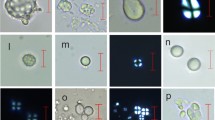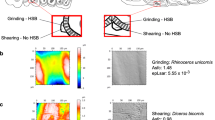Abstract
Food preferences of Arabian gazelle (Gazella arabica) on Farasan Islands, Saudi Arabia, were evaluated using focal animal sampling, ‘food tracking’ and an eco-morphological method examining tooth wear. Behavioural observations showed that gazelles generally consumed foliage, fruits and flowers of trees and shrubs, and to much lower extent annual and perennial herbs. Grass represents only 4.4% of the total time spent feeding at ground level. During dry season, gazelles spent significantly more time browsing on trees and shrubs and less time browsing on herbs than under wet conditions. Thus, consistent with predictions, gazelles are selective browsers. Major food plants are Acacia ehrenbergiana, Corchorus depres-sus and Capparis sinaica. During dry season the time spent feeding on fallen pods of Acacia and the time spent browsing on hind legs significantly increased. No sexual and age-related differences in the dietary choice of gazelles were revealed. The tooth wear signature of Farasan gazelles is dominated by abrasive food components classifying them with seasonally variable browsers and frugivorous dwarf ungulates. Based on the feeding behaviour we linked abrasion to the high mineral component of pods. Since the Farasan Islands are subject to high dust load, we also attribute the observed tooth wear signal to the high grit load.
Similar content being viewed by others
References
Al-Hazmi, MA, Ghandour, A.M., 1992. An ecological study of gazelles in western and southern regions of Saudi Arabia. J. Arid Environ. 23, 279–286.
Bärmann, E.V., Börner, S., Erpenbeck, D., Rössner, G.E., Hebel, C., Wörheide, G., 2013. The curious case of Gazella arabica. Mamm. Biol., https://doi.org/10.1016/j.mambio.2012.07.003.
Baharav, D., 1981. Food habits of the mountain gazelle in semi-arid habitats of eastern Lower Galilee, Israel. J. Arid Environ. 4, 63–69.
Baharav, D., 1983. Reproductive strategies in female mountain and dorcas gazelles (Gazella gazella gazella and Gazella dorcas).J. Zool. Lond. 200, 445–453.
Behairy, A.K.A., El-Sayed, M.K., Durgaprada Rao, N.V.N., 1985. Eolian dust in the coastal area north of Jeddah, Saudi Arabia. J. Arid Environ. 8, 89–98.
Campbell, P., 1997. A note on growing season food habits of mountain gazelles and Nubian ibex in Saudi Arabia. J. Arid Environ. 36, 705–709.
Collenette, S., 1985. An Illustrated Guide to the Flowers of Saudi Arabia. Scorpion Publishing, London.
Conradt, L., 1998. Could asynchrony in activity between the sexes causes intersexual social segregation in ruminant? Proc. R. Soc. Lond. B: Biol. Sci. 265, 1359–1363.
Cunningham, P.L., 2009. Observations on the seasonal dietary preference of male Gazella subgutturosa marica Thomas, 1897 (Cetartiodactyla: Bovidae) along foraging trails of central Saudi Arabia. J. Threat. Taxa 9(1), 445–449.
Cunningham, P.L., 2012. Plants included in the diet of Arabian Sand Gazelle (Reem) from Saudi Arabia. J. King Saud Univ. (Sci.), https://doi.org/10.1016/j.jksus.2012.10.002.
Cunningham, P.L., Wronski, T., 2011a. Twenty years of monitoring of the vulnerable Farasan gazelle Gazella gazella farasani on the Farasan Islands, Saudi Arabia: an overview. Oryx 45, 50–55.
Cunningham, P.L., Wronski, T., 2011b. Population structure of Farasan gazelle. Mammalia 75, 157–161.
Dubost, G., 1984. Comparison of the diets of frugivorous forest mammals of Gabon. J. Mammal. 65, 298–316.
Dunham, K.M., 1982. The foraging behaviour of impala (Aepyceros melampus). S. Afr. J. Wildl. Res. 12, 36–40.
Fortelius, M., Solounias, N., 2000. Functional characterization of ungulate molars using the abrasion-attrition wear gradient: a new method for reconstructing palaeo-diets. Novitates 3301, 1–36.
Flamand, J.R.B., Thouless, C.R., Tatwany, H., Asmodé, J.F., 1988. Status of the gazelles of the Farasan Islands, Saudi Arabia. Mammalia 52, 608–610.
Frey, W., Lösch, R., 2010. Geobotanik, Pflanze und Vegetation in Raum und Zeit.
Spektrum Akademischer Verlag, Heidelberg, Germany.
Gruvaeus, G., Wainer, H., 1972. Two additions to hierarchical cluster analysis. Br. J. Math. Stat. Psychol. 25, 200–206.
Habibi, K., 1992. Reproductive strategy of the Farasan gazelle Gazella gazelle farasani. J. Arid Environ. 23, 351–353.
Habibi, K., 1994. Elusive encounters: gazelles of the Farasan Islands. Aramco World 45, 10–15.
Habibi, K., Thouless, C., 1997. Ecology of sand and mountain gazelles in Saudi Arabia. In: Habibi, K., Abuzinada, A.H., Nader, I.A. (Eds.), The Gazelles of Arabia. National Commission for Wildlife Conservation and Development, Riyadh, pp. 88–110.
Hartigan, JA, 1975. Clustering Algorithms. John Wiley & Sons, New York.
Hofmann, R.R., 1991. Die Wiederkäuer. Biologie in unserer Zeit 21, 73–80.
IUCN/SSC Antelope Specialist Group, 2008. Gazella gazelle. The IUCN Red List of Threatened Species. Version 2014.2. https://doi.org/wwwiucnredlist.org (last accessed 30.07.14).
Janis, CM., 1990. The correlation between diet and dental wear in herbivorous mammals, and its relationship to the determination of diets of extinct species. In: Boucot, J. (Ed.), Evolutionary Paleobiology of Behaviour and Coevolution. Elsevier, Amsterdam, pp. 241–260.
Johnsingh, A.J.T., Sankar, K., 1991. Food plants of chital, sambar and cattle on Mun-danthurai Plateau, Tamil Nadu, South India. Mammalia 55, 57–66.
Kaiser, T.M., Fortelius, M., 2003. Differential mesowear in occluding upper and lower molars: opening mesowear analysis for lower molars and premolars in hyp-sodont horses. J. Morphol. 258, 67–83.
Kaiser, T.M., Rössner, G., 2007. Dietary resource partitioning in ruminant communities of Miocene wetland and karst paleoenvironments in Southern Germany. Paleobiology 252, 424–439.
Kaiser, T.M., Solounias, N., 2003. Extending the tooth mesowear method to extinct and extant equids. Geodiversitas 25, 321–345.
Kaiser, T.M., Brasch, J., Castell, J.C., Schulz, E., Clauss, M., 2009. Tooth wear in captive wild ruminant species differs from that of free-ranging conspecifics. Mamm. Biol. 74, 425–437.
Lerp, H., Wronski, T., Plath, M., Schröter, A., Pfenninger, M., 2013. Phylogenetic and population genetic analyses suggest a potential species boundary between Mountain (Gazella gazella) and Arabian Gazelles (G. arabica). Mamm. Biol. 78(5), 383–386.
Leuthold, W., 1971. Freilandbeobachtungen an Giraffengazellen (Litocranius walleri) im Tsavo-Nationalpark, Kenia. Z. Säugetierk. 36, 19–37.
Leuthold, W., 1978. On the ecology of the gerenuk Litocranius walleri. J. Anim. Ecol. 47, 561–580.
Louys, J.L., Meloro, C., Elton, S., Ditchfield, P., Bishop, L.C., 2011. Mesowear as a means of determining diets in African antelopes. J. Archaeol. Sci. 38, 1485–1495.
Main, M.B., 1998. Sexual segregation in ungulates: a reply. J. Mammal. 79, 1410–1415.
Mallon, D.P., Kingswood, S.C., 2001. Antelopes, Part 4: Northern Africa, the Middle East, and Asia. IUCN Global Survey and Regional Action Plan, Gland, Switzerland.
Mendelssohn, H., Yom-Tov, Y., Groves, C.P., 1995. Gazella gazella. Mamm. Species 490, 107.
Middleton, N.J., 1986. Dust storms in the Middle East. J. Arid Environ. 10, 83–96.
Neu, C.W., Byers, J.M., Peck, J.M., Boy, V., 1974. Atechnique for analysis of utilization-availability data. J. Wildl. Manage. 38, 541–545.
Nimazi, A.A., (Unpublished BSc thesis) 2008. Secondary Metabolites in Four Different Populations of Capparis decidua. King Saud University, Riyadh, Saudi Arabia.
Ngwa, A.T., Nsahlai, I.V., Bonsi, M.L.K., 2002. The rumen digestion of dry matter, nitrogen and cell wall constituents of the pods of Leucaena leucocephala and some Acacia species. J. Sci. Food Agric. 82, 98–106.
Owen-Smith, N., 1979. Assessing the foraging efficiency of a large herbivore, the kudu. S. Afr. J. Wildl. Res. 9, 102–110.
Reilly, B.K., Theron, G.K., Bothma, J., Du, P., 1990. Food preferences of Oribi Ourebia ourebi in the Golden Gate Highlands National Park. Koedoe 33, 55–61.
Rivals, F., Schulz, E., Kaiser, T.M., 2009. Late and middle Pleistocene ungulates dietary diversity in Western Europe indicates variations of Neanderthal paleoenvironments through time and space. Quat. Sci. Rev. 28, 3388–3400.
Ruckstuhl, K.E., Neuhaus, P., 2006. Sexual Segregation in Vertebrates—Ecology of the Two Sexes. Cambridge University Press, Cambridge.
Schulz, E., Fraas, S., Kaiser, T.M., Cunningham, P.L., Ismail, K., Wronski, T., 2013. Food preferences and tooth wear in sand gazelle (Gazella marica). Mamm. Biol. 78, 55–62.
Shalmon, B., 1987. The Arava gazelle. Isr.—Land Nat. 13, 15–18.
Shalmon, B., 1988. The ecology of Gazella gazella spp. in the southern Arava Valley. Isr. J. Zool. 35, 97.
Thouless, C.R., Al Bassri, K., 1991. Taxonomic status of the Farasan island gazelle. J. Zool. Lond. 223, 151–159.
Thouless, C.R., Grainger, J., Shobrak, M., Habibi, K., 1991. Conservation status of gazelles in Saudi Arabia. Biol. Conserv. 58, 85–98.
Vesey-Fitzgerald, D.F., 1952. Wild life in Arabia. Oryx 1, 232–235.
Wilmhurst, J.F., Fryxell, J.M., Bergman, CM., 2000. The allometry of patch selection in ruminants. Proc. R. Soc. B 267, 345–349.
Wilson, V.J., 2001. The Duikers of Africa: Masters of the Forest Floor. Chipangali Wildlife Trust, Bulawayo, Zimbabwe.
Wronski, T., 2013. Population development of Arabian Gazelles (Gazella arabica) on the Farasan Islands, Saudi Arabia. Zool. Mid. East 59 (3), 189–195.
Wronski, T., Mosfer, A.N., Plath, M., 2012a. Endemic Farasan gazelle (Gazella gazella farasani) enhance the dispersal of invasive Prosopis juliflora on Farasan Islands, Saudi Arabia. Rev. Ecol. (Terre Vie) 67, 329–337.
Wronski, T., Alageel, K., Ismail, K., Islam, Z., 2012b. Aerial and Ground Survey of Farasan Mountain Gazelles (Gazella gazella) on Farasan Islands (June 2012) Quarterly Report July-September 2012. Khalid Wildlife Research Centre, Thumamah, Saudi Arabia.
Author information
Authors and Affiliations
Corresponding author
Rights and permissions
About this article
Cite this article
Wronski, T., Schulz-Kornas, E. The Farasan gazelle—A frugivorous browser in an arid environment?. Mamm Biol 80, 87–95 (2015). https://doi.org/10.1016/j.mambio.2014.12.002
Received:
Accepted:
Published:
Issue Date:
DOI: https://doi.org/10.1016/j.mambio.2014.12.002




